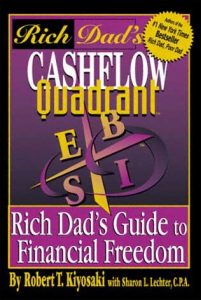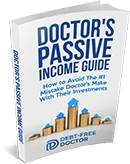Rich Dad’s Cashflow Quadrant Explained: A Quick Guide
Have you ever wondered how wealthy people seem to have more time and money—while you’re still trading hours for dollars?
If you’re a doctor, dentist, or other high-income earner, this might sound familiar: you’ve worked hard, followed the traditional education path, and got a “good job.” But despite your income, you’re still chasing financial security.
I was in your shoes. A successful periodontist on paper, but the more I earned, the more I worked. It wasn’t until I picked up Rich Dad Poor Dad and later Cashflow Quadrant by Robert T. Kiyosaki that I realized the truth: I was stuck on the wrong side of the Cashflow Quadrant.
Don’t Miss Any Updates. Each week I’ll send you advice on how to reach financial independence with passive income from real estate.
Sign up for my newsletterWhat Is the Cashflow Quadrant?
Kiyosaki created the Cashflow Quadrant to explain the four main ways people earn money:
-
E: Employee
-
S: Self-Employed
-
B: Big Business Owner
-
I: Investor
Each quadrant reflects a different mindset, level of financial literacy, and path to financial success. The left side—E and S—is where most of the middle class lives. The right side—B and I—is where the rich live.
Understanding which quadrant you’re in—and how to shift to the right side—is one of the best ways to unlock true financial freedom.
Related: Rich Dad’s Cashflow Quadrant: A Summary That’ll Transform Your Thinking
Poor Dad vs. Rich Dad: The Mindset Shift
Kiyosaki’s Rich Dad was actually his best friend’s father, a small-business owner who taught him how the wealthy think. His Poor Dad was his biological father—a well-educated college professor who believed in job security, pension plans, and climbing the career ladder.
This contrast highlighted one of the biggest differences between the wealthy and the working class:
- Rich people build assets.
- Poor people collect liabilities and call them assets.
Most of us were raised by a Poor Dad mindset: “Go to school, get a good job, and play it safe.” We’re taught nothing about financial statements, cash flow, or risk management. And we definitely don’t learn how to make our money work for us.
The Four Quadrants Explained
E Quadrant: Employee
Employees value a steady paycheck, benefits, and job security. But they also have the least control over their financial future. Most doctors and professionals begin here.
You exchange time for earned income. And the only way to make more is to work more. Plus, you pay the most in taxes, with few tax breaks.
Pros:
-
Job stability
-
Predictable income
Cons:
-
No leverage
-
High taxes
-
Limited time freedom
S Quadrant: Self-Employed
This quadrant includes dentists in private practice, small-business owners, consultants, and other high-income professionals. You may be your own boss, but the business still relies on YOU. If you stop working, the income stops.
Self-employed individuals often believe they have more control, but they’re still trading time for money. And they still pay a lot in taxes.
This was me for years—owning my practice, but my practice owning me.
Pros:
-
Independence
-
Control over operations
Cons:
-
Limited scalability
-
Still time-bound
-
Few passive income streams
B Quadrant: Business Owner
This is where the real shift happens. People in the B quadrant own systems and hire people to run them. They may have several locations, teams, and processes that work without their daily involvement.
Kiyosaki says: “The only difference between a big business owner and a self-employed person is systems.”
As a B-quadrant owner, you’re building long-term wealth through systems—not hours.
Pros:
-
Leverage people and systems
-
Lower taxes
-
True time freedom
Cons:
-
Requires leadership skills
-
More complexity
-
Higher upfront investment
I Quadrant: Investor
This is the holy grail.
Investors let money work for them. They earn passive income through assets like real estate, stocks, private equity, or even owning businesses through equity stakes. They focus on the balance sheet, not the income statement.
They understand cash flow, tax strategy, and financial intelligence. They’re not glued to a dental chair or locked into 50-hour weeks.
This quadrant includes successful investors, fund managers, and anyone building passive income through assets that pay them monthly.
Pros:
-
Passive income
-
Financial freedom
-
Low time commitment
Cons:
-
Requires financial education
-
Potential investment risks
The Goal: Move to the Right Side
Doctors and dentists are often stuck in the S quadrant. The work is demanding, and the number of hours you work determines your income. But unless you shift to the B or I quadrant, you’ll never stop trading time for money.
Most of the richest people in the world build wealth in the B and I quadrants. They acquire good deals, invest in cash-flowing assets like rental properties, businesses, or commercial real estate, and use strategies like tax breaks and legal structures to accelerate wealth.
Don’t Miss Any Updates. Each week I’ll send you advice on how to reach financial independence with passive income from real estate.
Sign up for my newsletterWhy This Matters to High-Income Professionals
If you’re a dentist/doctor making $400k a year but working 60 hours a week and have no passive income, you’re not wealthy. You’re vulnerable.
The wealthy don’t rely on a job. They own assets, delegate, and earn income while they sleep.
Want to build long-term wealth and true financial security? You need to stop focusing on earned income and start focusing on assets and ownership.
How I Made the Shift
Reading Cashflow Quadrant wasn’t just a book review moment—it was a turning point. I started investing in real estate, syndications, and assets that paid me regardless of my delivery times or clinic hours.
I learned about:
-
Real estate syndications (group investing)
-
Private equity funds
-
Passive income through RV parks and mobile home parks
-
Using my own money or capital from private money lenders
Now, my practice is optional. I work because I want to—not because I have to.
Mindset Shifts You Need to Make
Here’s what I wish I knew in dental school:
-
Financial literacy matters more than your income
-
A high salary doesn’t equal wealth
-
You won’t build wealth working for money—you need to own things
-
Don’t be afraid of failure—it teaches the best lessons
The self-employed quadrant is full of smart people who work hard. But hard work isn’t the same as smart wealth building.
What You Can Do Next
If you’re ready to shift to the right side of the Cashflow Quadrant, start here:
-
Build financial literacy (read, listen, watch)
-
Learn about real estate investing, syndications, and private equity
-
Track your net worth and balance sheet monthly
-
Stop buying liabilities—buy income-producing assets
-
Surround yourself with people who think differently
Kiyosaki talks about green houses and red hotels—buy small cash-flowing assets and scale up. In the world of business, this could mean owning part of a surgery center, real estate fund, or an online business.
The main takeaway? Move from employee/self-employed to business owner/investor. That’s where the freedom is.
Ready to Shift Quadrants?
Stop depending on social security, pension plans, or the hope of a perfect stock market. Those are legal Ponzi schemes for the middle class.
Start building wealth the way rich people do—with ownership, passive income, and mindset shifts.
💡 Want to make the jump to the right side? Join the Passive Investors Circle.
We help doctors and high-income professionals like you invest smarter and build true financial freedom.
FAQs
What’s the biggest difference between the left and right side of the quadrant?
Time. On the left, you trade time for money. On the right, your money and people work for you.
Can I still be a dentist and build passive income?
Absolutely. Keep your practice—but start redirecting your profits into income-producing assets.
How do I start if I’ve never invested before?
Start small. Educate yourself. Consider joint ventures, private funds, or real estate syndications to dip your toe in.
Is the Cashflow Quadrant just for entrepreneurs?
Nope. It’s a framework for anyone who wants greater control, freedom, and wealth.
What’s the best way to learn about investing if I’m busy?
Podcasts, audiobooks, and YouTube. No excuse in today’s world. You can learn while driving to the office.



